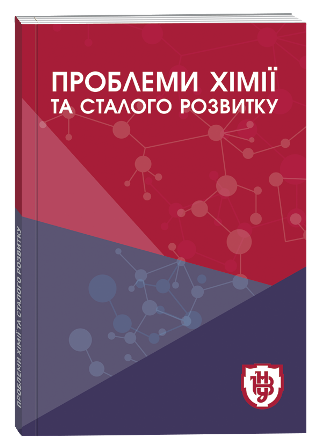GLASS-FORMATION REGIONS AND THERMAL PARAMETERS OF THE GLASSES IN THE Ag2Se–Zn(Cd,Hg)Se–GeSe2 SYSTEMS
DOI:
https://doi.org/10.32782/pcsd-2021-2-4Keywords:
сhalcogenide glasses, quasi-ternary systems, characteristic temperaturesAbstract
The glass-formation regions in the quasi-ternary systems Ag2Se–(Zn, Cd, Hg)Se–GeSe2 were determined using the XRD data. The maximum content of the modifier ZnSe that could be introduced while preserving the glassy state is 10 mol.%, the respective value for CdSe is 12 mol.%. The largest region of the existence of glasses is observed in the mercury-containing system where it crosses the entire concentration triangle. The minimum content of the glass-forming component GeSe2 is 43 mol.%. Thermal properties of the glasses were characterized by the glass transition temperature, the crystallization temperature and the melting point of the crystallized alloy. The relationship of the thermal parameters and the fields of the primary and secondary crystallization of the respective equilibrium compositions was illustrated for the glasses of the mercury-containing system.
References
Виноградова Г.С. Стеклообразование и фазовые равновесия в халькогенидных системах. Мoсква : Наука, 1984. 238 с.
Abe K., Takebe H., Morinaga K. Preparation and properties of Ge–Ga–S glasses for laser hosts. J. Non-Cryst. Solids. 1997. № 212. P. 143-150.
Vlassov Yu.G., Legin A.V., Rudnitskaya A.M. Electronic tongues: new analytical perspective for chemical sensors. J. Anal. Chem. 1997. № 528. P. 758-762.
Parasyuk O.V., Olekseyuk I.D., Piskach L.V., Romanyuk Ya.E. Phase equilibria in the quasiternary systems AI
X–BIIX–CIVX2 (AI–Cu, Ag; BII–Zn, Cd, Hg; CIV–Si, Ge, Sn; X–S, Se, Te), 6th Int'l Conf. "Phase Diagrams in Materials Science", Abstract, Kyiv, 2001, p.40.
Quenez P., Gorochov O. Preparation et proprietes de monocristaux de Cd4GeSe6. J. Crystal Growth. 1974. № 26. P. 55-58.
Moтря С.Ф., Ворошилов Ю.В., Пoтoрий M.В., Сeмрaд E.E. Фазовые равновесия в системах Ge(Sn)Se2–HgSe. Укр. Хим. Журн. 1986. № 52. C. 807-809.
O.V. Parasyuk, L.D. Gulay, Ya.E. Romanyuk, I.D. Olekseyuk, L.V. Piskach. The Ag2Se–HgSe–GeSe2 system and crystal structures of the compounds. J. Alloys Comp. 2003. № 351. P. 135-144.
H. Haueseler, M. Himmrich. Die Kristallstructur von silbergermaniumselenid Ag2HgGeSe4. Z. Naturforsch. B. 1989. № 44. P. 1035-1037.
I.D. Olekseyuk, V.V. Bozhko, O.V. Parasyuk, V.V. Galyan, I.I. Petrus`, Glass formation and Properties of Glasses of the Quasi-ternary Zn(Cd,Hg)Se–Ga2Se3–SnSe2 System. Functional Materials. 1999. № 6. P. 550-554.
Галян В.В. Вплив модифікаторів (HgSe, Cu2Se) на фізичні властивості склоподібного диселеніду германію : автореф. дис. … канд. фіз.-мат. наук., Волинський держ. ун-т, Луцьк, 2003. 21 с.
Robinel E., Kone A., Duclot M.J., Souquet J.L. Silver sulfide based glasses (II). Electrochemical properties of GeS2–Ag2S–AgI glasses: transference number measurement and redox stability range. J. Non-Cryst. Solids. 1983. № 57. P. 59.
Ivanova Z.G., Vassilev V.S., Boycheva S.V., Kirov N. Topological transition and rigidity percolation in Ge–Se(S)–Cd glasses. J. Non-Cryst. Solids. 1998. № 232/234. P. 274-277.
Олексеюк I.Д., Парасюк O.В., Божко В.В., Галян В.В., Петрусь I.I. Склоутворення в квазіпотрійних системах (Zn, Cd, Hg)Se–Ga2Se3–GeSe2. Наукові записки Рівненського педінституту. 1997. № 3. С. 148-152.
Горгут Г.П. Фазові рівноваги і властивості проміжних фаз у системах Ag2X – Ga2X3 – GeX2 (X – S, Se) : автореф. дис. … канд. хім. наук. Львівський нац. ун-т. Львів, 2002. 20 с.
Штец П.П, Губин В.M., Биланич В.С., Якимчук M.Н., Туряниця I.Д. Получение и свойства сложных полупроводников. Kиїв: УМК ВО, 1991. 132 с.
Kauzmann W. The Nature of the Glassy State and the Behavior of Liquids at Low Temperatures. Chem. Rev. 1948. № 13. P. 219–256.






